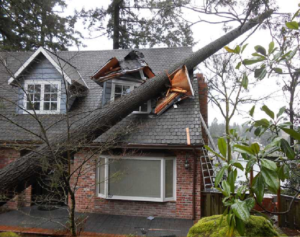Is Mold Testing and Remediation Covered by Homeowners’ Insurance?

When does homeowners insurance usually cover mold testing and remediation?
In general, mold inspections and removal are only covered when the source of the mold is already covered in your homeowners’ policy, such as water damage. Standard homeowners’ insurance policies protect you from water damage caused by sudden and accidental incidents, such as a burst pipe or an overflow resulting from a malfunctioning AC unit.
If the resulting moisture from such an issue causes mold to develop, you’d be able to file a claim for mold assessments and remediation, as well as for the repair of any property permanently damaged by the mold, under your water damage coverage.
Some examples of when mold testing is covered by home insurance
- Your water heater leaks water that causes black mold to grow on the surrounding walls.
- You have a home fire, and mold develops after firefighters use water to extinguish the flames.
- Your dishwasher leaks and floods your kitchen, resulting in mold growing along the base of your cabinetry and the basement below.
- A tree falls on your roof causing rain to get in.
When does homeowners’ insurance exclude coverage for mold testing and remediation?
Mold caused by your own neglect and lack of maintenance will likely be denied by your home insurance company. Over time, a minor leak could cause mold to spread throughout the surrounding area. If you tried to file a claim for the leak—and the resulting mold—weeks or even days after the leak became apparent, your insurance provider would likely claim that you failed to act immediately and therefore deny coverage.
Also, no mold damage resulting from a regional flood will be covered, since flooding is usually excluded from your homeowner’s insurance policy. However, if you purchased a separate flood insurance policy, that coverage would extend to any mold damage caused by a flood.
Some examples of when mold isn’t covered
- Your bathtub or shower has leaked for years, resulting in a mold infestation.
- You live in a humid climate and failed to use a dehumidifier in your basement, and black mold grew as a result.
- A storm causes flooding, and you did not install a waterproofing system in your basement causing subsequent mold growth, in your home.
- Water from mopping a wood floor caused the wood to swell and develop mold.

In some cases, your mold claim will coincide with the claim you file for the incident that caused the mold. For example, if a pipe burst and flooded your house, your insurance company may send a mold remediation team to properly dry your home in order to prevent mold from ever growing in the first place.
This is ideal, since it will minimize damage and prevent you from paying a deductible for two separate claims — one for repairing the damage from the broken pipe, the other for the future mold removal.In these situations, ask your insurance agent if the necessary mold assessment and remediation is totally covered by your claim. Also, keep meticulous records of all damaged areas and repairs in order to support potential future claims. In other cases, you might discover mold some time after water damage has occurred.
In these situations, you’ll need to prove that the mold is resulting from the covered peril and not a new leak or lack of maintenance. If this is true, follow these steps to file a claim:
- Contact your insurance agent as soon as possible. They’ll need to send an adjuster to assess the total cost of the damage and evaluate whether it is, indeed, related to a covered claim.
- Contact a licensed mold assessor such as Certified Inspections, Inc. to test for mold and write a protocol if the results merit one.
- Open windows or run a dehumidifier or fan in order to dry out the room and prevent further mold growth. However, don’t try to clean or remove anything. The insurance adjuster needs to review all damaged property.
- Photograph all damaged areas and property, and gather any relevant photos you have from the prior water damage to supplement your claim.
- Review your policy or consult your agent to determine your policy’s mold coverage limits.
Explaining the nature of the problem to your mold assessor will help him put that information into his report which you will give to the insurance company. As best as possible, try to prove that this mold is related to your initial water damage claim. That way, you won’t get stuck paying two separate deductibles. However, it’s in your insurance company’s best interest to view the damage as a separate claim. So you shouldn’t be surprised if you encounter some resistance when trying to reopen a former claim.
Review your policy and consider switching your homeowners’ insurance company
Ask your homeowners’ insurance company whether it provides coverage for mold. Some insurance companies have dropped coverage for mold altogether,
Some companies provide mold coverage, but imposes a $5,000 coverage limit on claims. If mold is a big concern for you, consider switching insurance providers to one that offers coverage. Not only will you obtain some coverage for mold, you could potentially lower your home insurance rates by switching insurers.
Finally, a lot depends on luck. The same policy may result in coverage being denied or accepted by two different insurance agents at the same company. It even may come down to something as mundane as what kind of mood the person is in at that moment. Maybe he or she didn’t get a good night’s sleep or had a fight with their spouse, or on the other hand, just received some great news and is a good mood. This article provides general guidance, but there are no definitive rules etched in stone, and no “one size fits all” answer.
